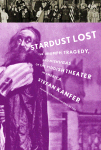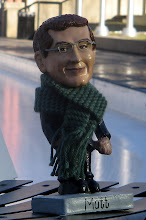 I just listened to a radio interview with writer Stefan Kanfer, on NPR's Fresh Air. Kanfer talked about the history of Yiddish theater, which he wrote about in a book called Stardust Lost: The Triumph, Tragedy, and Mishugas of the Yiddish Theater in America. Among the major figures they discussed were Boris and Bessie Thomashefsky, the grandparents of Michael Tilson Thomas. This NY Times review of Kanfer's book describes Boris' popularity and ability to captivate audiences:
I just listened to a radio interview with writer Stefan Kanfer, on NPR's Fresh Air. Kanfer talked about the history of Yiddish theater, which he wrote about in a book called Stardust Lost: The Triumph, Tragedy, and Mishugas of the Yiddish Theater in America. Among the major figures they discussed were Boris and Bessie Thomashefsky, the grandparents of Michael Tilson Thomas. This NY Times review of Kanfer's book describes Boris' popularity and ability to captivate audiences:The audience demanded Acting above all — large emotions, dramatic gestures. This was a blessing for many in the Yiddish theater who were mainly entertainers. Thomashefsky reveled in mesmerizing the crowds. A matinee idol and ladies’ man, he enthralled a generation of young women, apparently inducing one to begin tearing her clothes off at the sight of his famous calves. This woman was just one of scores of “patriotn,” or fans, who passionately followed their favorite actors, engaging in heated arguments and even fistfights over who was the Yiddish theater’s supreme artist.
Kanfer talks quite a bit about how Yiddish theater has influenced popular culture - from the musical Fiddler on the Roof (based on a Yiddish play called Tevye the Milkman) to a less obvious influence on Cole Porter. Even Pablo Casals asked his students to sound "more Jewish," Kanfer says, asking for a lamenting, plaintive quality that Yiddish theater performers perfected. Even as such sounds entered our popular culture, and spread into vaudville, the Yiddish theater itself has all bit disappeared, along with a great deal of plays, music, and performers.
Next week our orchestra will be revive a bit of Yiddish theater, with a program called The Thomashefskys: Music and Memories of a life in the Yiddish Theater. Michael Tilson Thomas will conduct a small orchestra and several singers on two concerts, January 12 and 13. I'm not playing, but I'm looking forward to hearing it from the audience, since it seems like a rare chance to hear some fascinating, whimsical songs.


 Technorati Link Count: no. of blog reactions to this post
Technorati Link Count: no. of blog reactions to this post
No comments:
Post a Comment